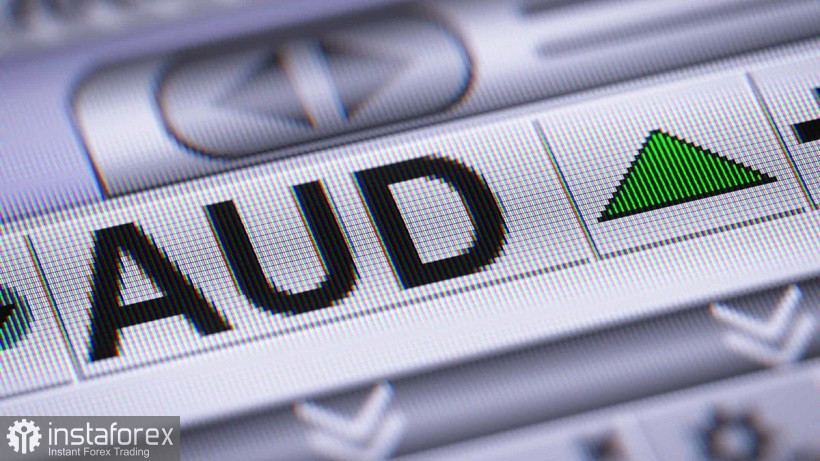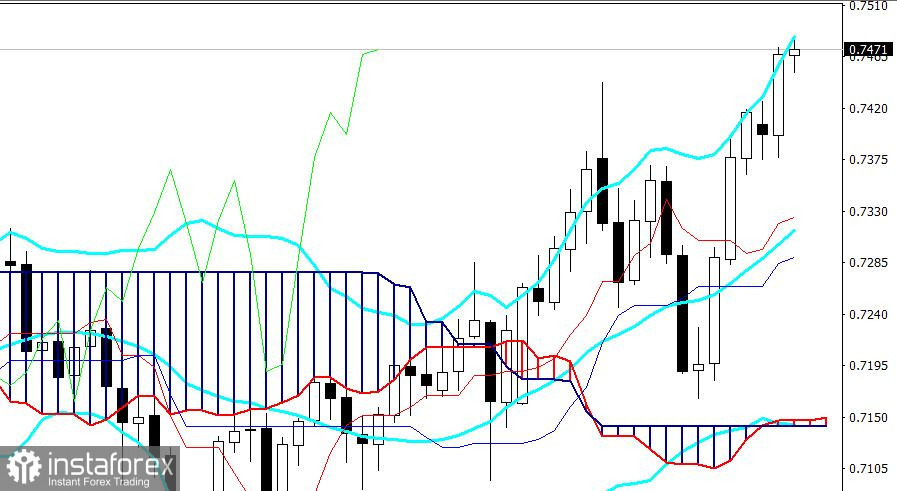The Australian dollar is actively strengthening against the greenback, even despite the growth of the US dollar index. The AUD/USD pair jumped by more than 300 points in just a week, reaching 0.7460 (this is the price high since October last year). The upward dynamics is almost recoilless, which is very surprising, given the unstable geopolitical situation and "voltage surges" in the context of strengthening/weakening the level of anti-risk sentiment. The aussie actually ignores contradictory signals of a fundamental (geopolitical) nature, continuing to gain momentum. Now the 75th figure has appeared on the horizon, which is likely to become easy prey for AUD/USD bulls.

In general, the stars are really very well formed for the aussie. Key macroeconomic indicators are showing positive dynamics, the Reserve Bank of Australia is voicing hawkish signals, and the degree of anti-risk sentiment has slightly decreased. And although the AUD/USD pair is heavily overbought at the moment, many experts have no doubt that bulls will soon try to gain a foothold in the area of the 75th figure. The aussie has been strengthening at an active pace for the second consecutive week, and at the moment there are no obvious prerequisites for a trend reversal.
Let's start with macroeconomic reports. Firstly, we are talking about inflation. Unfortunately, Australia publishes quarterly, not monthly reports (despite the fact that the head of the RBA has repeatedly advocated monthly publications), so we can now operate with data for the 4th quarter of last year. During this period, the overall consumer price index jumped to 1.3% in the country. For comparison, it should be noted that in the third quarter, Australian inflation rose to 0.8%. Indirect inflation indicators suggest that the CPI will also show significant growth in the first quarter of this year. But the unemployment rate in February remained at 4.2%. The indicator was released at the same level in January. This suggests that unemployment has remained at the level of multi-year lows – the last time the indicator was in this area was in August-September 2008.
Against the background of such trends, the RBA decided to end its bond purchase program worth 350 billion Australian dollars ahead of schedule. But at the same time, the central bank did not announce an increase in the interest rate at the March meeting, pointing to a temporary, rather than steady, increase in inflation. Such soft rhetoric disappointed traders, as market participants put at least one rate hike in prices until the end of 2022. The aussie plunged again, reaching 0.7150 against the greenback.
The situation changed last week. RBA Governor Philip Lowe unexpectedly admitted the possibility of an interest rate hike within the current year. He noted that the central bank expects "fairly strong economic growth this year," so it is "quite likely" that the rate may be increased "later this year." According to him, a surge in world commodity prices may push inflation to a jump in growth, to which the Australian central bank will respond accordingly.
Yesterday, Philip Lowe repeated this thesis. He made it clear that the growing inflationary pressure indicates the risks of an earlier than expected step to tighten the parameters of monetary policy by the RBA. However, at the same time, he clarified that in order to raise the rate, the central bank needs "evidence of widespread and sustained price pressure." However, the market did not pay attention to this "curtsey" of a dovish nature, isolating only hawkish hints from Lowe's rhetoric.
The Australian dollar is also supported by the external fundamental background. Despite the Ukrainian events, the craving for risk in the market has increased against the background of ongoing negotiations between Russia and Ukraine. In addition, today there are clear signs that Germany is not ready for an escalation of the situation in Eastern Europe. In particular, German Chancellor Olaf Scholz categorically ruled out the possibility of involving NATO in the events in Ukraine, including sending peacekeepers or creating a no-fly zone. Speaking in the Bundestag, he said that his country "definitely will not go for it." It is worth recalling here that earlier the United States also did not support this idea proposed by representatives of Poland.
Thus, the prevailing fundamental background indicates the priority of long positions – at least in the coming days.

From a technical point of view, the pair on the daily chart is between the middle and upper lines of the Bollinger Bands indicator, as well as above all the lines of the Ichimoku indicator, which shows a bullish Parade of Lines signal. All this suggests that the pair retains the potential for its further growth - at least to the first resistance level of 0.7480 (the upper line of the Bollinger Bands indicator on D1). A break of this level will open the way to the next resistance level - 0.7510 (the upper boundary of the Kumo cloud on the W1 timeframe).





















